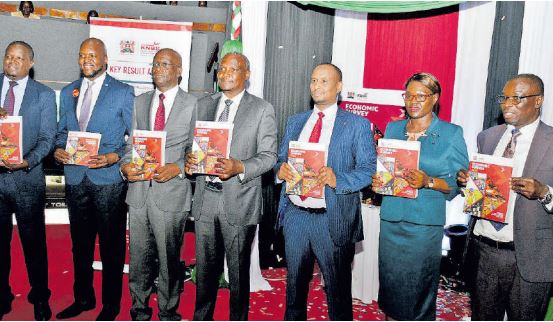
A subdued performance in the agricultural sector, high interest rates and a drop in the number of job opportunities created, saw Kenya's economy grow at a slower pace of 4.7 per cent slower compared to 5.7 per cent a year earlier.
New data contained in the Kenya National Bureau of Statistics - Economic Survey 2025, shows that despite massive investments in agriculture last year, the sector growth dipped.
Agriculture, which accounts for more than a fifth of the economy or gross domestic product (GDP), grew at a slower rate of 4.4 percent last year compared to 7.7 per cent growth in 2023 due to reduced maize production and exports of horticultural produce to the European market.
Maize production dipped from 47.6 to 44.7 million 90kg bags, and horticulture exports declined by 14.1 per cent due to logistical challenges and pest control regulations.
“At one point, we feared it could slow further to 4.6 per cent. Factors such as constrained fiscal space, high debt servicing costs, post-pandemic socioeconomic unrest, and frequent extreme weather events have significantly disrupted economic activity,” said National Treasury CS John Mbadi.
There was also a slow growth in other sectors like manufacturing that showed modest improvement, growing 2.8 per cent in 2024 compared to 2.2 per cent the previous year, contributed 7.3 per cent to GDP.
In 2024, the volume of output increased by 4.4 per cent compared to 2.8 per cent the previous year.
Formal manufacturing employment rose by 1.9 per cent to 369200 persons, with the sector accounting for 11.5 per cent of the share of formal employment.
KNBS said that the growth, albeit slower than the previous year, was to a large extent supported by activities in Agriculture, Forestry & Fishing, which grew by 4.6 per cent, Financial & Insurance Activities (7.6 per cent), Transportation and Storage (4.4 per cent) and Real Estate (5.3 per cent).
Other key sectors that posted significant growth in the period under review are Wholesale and Retail (3.8 per cent), Information & Communication (7.0 per cent), Accommodation & Food Service (25.7 per cent) and Public Administration (8.2 per cent).
KNBS CEO Macdonald Obudho said that Kenya’s transportation and storage sector recorded a 6.4 per cent growth in output, rising from Sh3.28 trillion in 2023 to Sh3.48 trillion in 2024.
The sector’s growth was largely driven by road transport, which continued to dominate the industry, accounting for 75.1 per cent of the sector's total value in 2024, slightly down from 76.9 per cent in 2023.
Government expenditure on road maintenance surged, with actual disbursements increasing by 20.1 per cent to Sh80.1 billion during the 2023/24 fiscal year.
“Despite increased investment in infrastructure, the number of newly registered road motor vehicles fell sharply by 21.4 per cent, totaling 93,646 in 2024. Similarly, registrations of motorcycles, autocycles, and three-wheelers declined by 4.7 per cent to 72,868,” said Obudho in the report.
However, the sector also saw an 11.8 per cent increase in reported road traffic accidents, which rose to 11,173 cases in 2024, highlighting growing safety concerns even as the road network expands.
On the rail front, freight volumes transported via the Metre Gauge Railway (MGR) rose slightly to 1.03 million tonnes, up from 1.00 million tonnes in 2023.
However, passenger numbers on both the MGR and the Standard Gauge Railway (SGR) fell significantly. MGR passenger numbers dropped by 26.9 per cent to 2.52 million, while SGR passengers declined by 10.3 per cent to 2.45 million in 2024.
Interestingly, despite the drop in passenger numbers, SGR passenger revenue soared by 39.4 per cent, reaching Sh4.1 billion in 2024, suggesting increased fares or longer-distance travel patterns.
KNBS noted that in the review period, exports rose by 10.4 per cent to Sh1.12 trillion, while imports grew more modestly by 3.3per cent to Sh2.7 trillion.
The trade deficit narrowed from Sh1.9 trillion to Sh1.6 trillion, and the export-import cover ratio improved from 38.6per cent to 41.1per cent.
“The United States remained the top source of remittances, contributing Sh354 billion out of a total Sh674.1 billion. China led as Kenya's largest import partner (Sh576.1 billion), while Uganda was the top export destination (Sh125.9 billion), followed by the U.S. (Sh88.9 billion) and the Netherlands (Sh72.5 billion),” said Obudho.
Exports included horticultural products, tea, coffee, and apparel, while key imports comprised petroleum products, industrial machinery, and iron and steel.
The year was, however, marred by issues in the mining sector that saw Kenya’s total mineral production value fall sharply from Sh33.8 billion in 2023 to Sh25.5 billion in 2024, primarily due to a significant decline in earnings from titanium minerals.
According to newly released industry data, the downturn in titanium revenue had the largest impact on the overall performance of the mining sector. Other minerals also posted mixed results.
Soda ash was a bright spot, with its value rising to Sh2.2 billion in 2024 from Sh1.7 billion the previous year, reflecting growing demand or improved production.
However, the sector faced further setbacks with the value of crude salt plummeting by 98.5 per cent, from Sh55.1 million in 2023 to a mere Sh0.8 million in 2024.
Meanwhile, soapstone earnings dropped by 70.2 percent, amounting to just Sh21.7 million during the review period.
Kenya’s tourism sector, on the other hand, recorded a strong recovery in 2024, with international visitor arrivals rising by 14.7 percent to 2.39 million, driven by strategic interventions and increased global confidence in the country as a travel destination.
The sector’s performance was bolstered by a range of factors, including enhanced marketing efforts, improved infrastructure, and the hosting of major international events.
Accommodation services also expanded significantly during the year. The number of accredited hotels rose to 904, comprising 289 gold-rated, 317 silver-rated, and 298 bronze-rated establishments.
Hotel bed-night occupancy increased by 18.9 percent to reach 10.26 million, reflecting the growing demand for lodging.
Conference tourism posted moderate gains, with international conferences up by 2.3 percent to 999 events, while local conferences rose by 4.7 percent to 11,225.
The increase was largely supported by the surge in visitor numbers and the successful hosting of high-profile meetings.
Cultural and educational tourism also saw a boost, with visits to museums, snake parks, and historical sites climbing by 6.9 percent to 1.15 million in 2024.
The sector’s strong performance underscores a broader recovery in Kenya’s economy and reinforces the importance of tourism as a key driver of national growth.








